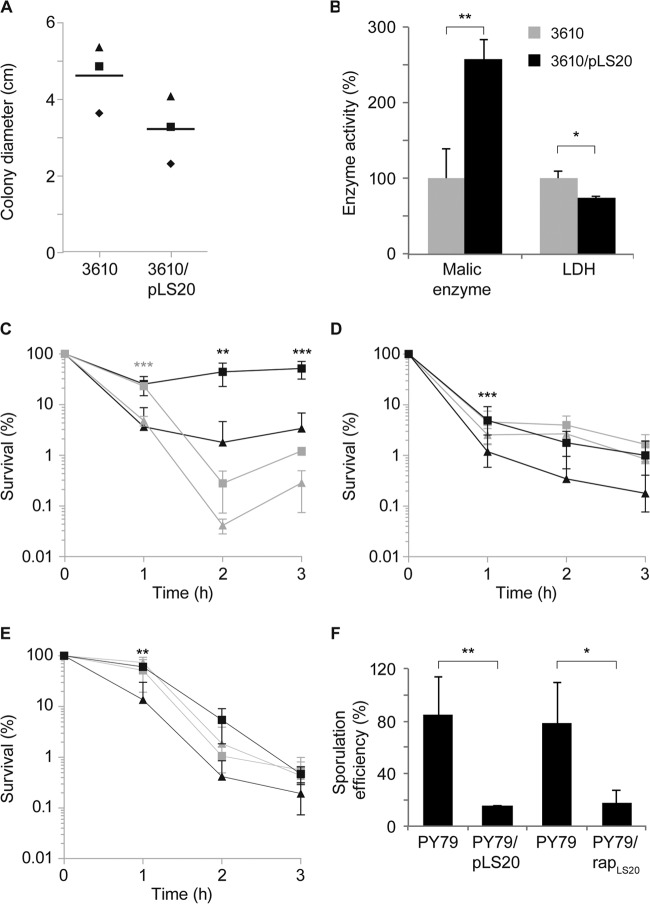FIG 3.
Conjugative plasmid pLS20 changes the cellular physiology of its host. (A) The conjugative plasmid pLS20 slows down the swimming motility behavior of its host. Cells were grown to the mid-exponential growth phase and adjusted to the same OD, and the same volumes of cultures were centrally spotted on soft agar plates containing 0.3% (wt/vol) agar and incubated at 37°C for 5 h. The diameter of colony spreading was determined from at least 10 plates for each experiment, and the means of each experiment are plotted in corresponding symbols for each strain. A horizontal line shows the means of the three experiments. The P value was calculated by using a two-sided dependent sample t test. P = 0.0045 compared to the pLS20-free strain. (B) Malic enzyme and lactate dehydrogenase (LDH) activity of plasmid-free strains and strains containing the conjugative plasmid pLS20. Cells were grown to the mid-exponential-growth phase and harvested, and the lysate was tested for the specific activity of malic enzymes or LDH by following the absorption of NADH at 365 nm. Error bars denote standard deviations. P values were calculated by using two-sided independent sample t tests. P < 0.05 (*) and P < 0.01 (**) compared to the pLS20-free strain. (C to E) Survival of cells containing pLS20 (squares) or lacking pLS20 (triangles) under different stress conditions. Cells were grown to the mid-exponential growth phase and were treated with 5% (wt/vol) sodium chloride (black) or 10% (vol/vol) ethanol (gray) (C), exposed to acid stress at pH 4.5 (black) or alkaline stress at pH 9 (gray) (D), and exposed to cold shock at 15°C (black) or heat shock at 54°C (gray) (E). Survival was assayed by plating appropriate dilutions after 1 h, 2 h, and 3 h. Each time point is the average from three independent experiments, and error bars denote standard deviations. P values were calculated by using two-way ANOVA. Significant differences in survival of the pLS20-containing strain compared to the pLS20-free strain were found under conditions of salt, ethanol, acid, and cold stress (P < 0.005). Bonferroni's posttest was used for pairwise comparisons. P < 0.01 (**) and P < 0.001 (***) compared to the plasmid-free strain. (F) The conjugative plasmid pLS20 inhibits sporulation of its host. Cells were grown in Difco sporulation medium (DSM) for 24 h at 37°C and plated in triplicate. PY79/rapLS20 denotes induction of RapLS20 expression from an ectopic site on the chromosome in cells lacking pLS20. Data were derived from three independent experiments, and error bars denote standard deviations. P values were calculated by using two-sided independent sample t tests. P < 0.05 (*) and P < 0.01 (**) compared to strain PY79.

